If you’re looking to upgrade your home climate in 2025, I recommend checking out the top smart thermostats like ecobee’s Enhanced and Premium models, the Nest Learning Thermostat, and Honeywell options. These devices support most HVAC systems, integrate seamlessly with voice assistants, and offer energy-saving features like occupancy sensing and scheduling. They also feature sleek designs and easy setup for DIY installation. Keep exploring to find the perfect smart thermostat that fits your home and lifestyle.
Key Takeaways
- Top smart thermostats offer seamless smart home integration, voice control, and energy-saving features for enhanced home climate management.
- Compatibility spans most HVAC systems, including heat pumps and zone controls, ensuring broad applicability.
- User-friendly interfaces with touchscreens or apps simplify setup, remote control, and monitoring.
- Many models support Matter protocol, enabling interoperability across major smart home platforms and ecosystems.
- ENERGY STAR certified options provide significant energy savings and advanced features like occupancy sensing and scheduling.
ecobee Smart Thermostat Enhanced

If you’re looking to save money on energy bills while maintaining a comfortable home, the ecobee Smart Thermostat Enhanced is an excellent choice. It can cut your heating and cooling costs by up to 26% annually by automatically adjusting the temperature when you’re away and preheating or precooling your home before you arrive. The thermostat also manages humidity for consistent comfort day and night. With remote control via smartphone, tablet, or Apple Watch, and compatibility with major smart home platforms like Alexa and Siri, it’s easy to integrate and operate. Its easy installation, including a Power Extender Kit, makes setup simple, even without a C-wire.
Best For: Homeowners seeking to reduce energy costs while maintaining personalized, smart comfort control with easy installation and compatibility across major smart home platforms.
Pros:
- Saves up to 26% annually on heating and cooling costs through automatic adjustments.
- Compatible with a wide range of HVAC systems and smart home platforms, including Siri, Alexa, and Google Assistant.
- Supports SmartSensor technology for room-specific temperature control, enhancing comfort and efficiency.
Cons:
- Requires a C-wire or Power Extender Kit for installation in homes without existing wiring.
- May have a learning curve for users unfamiliar with smart home technology.
- Limited to homes with compatible HVAC systems, which may exclude some older or specialized setups.
Amazon Smart Thermostat
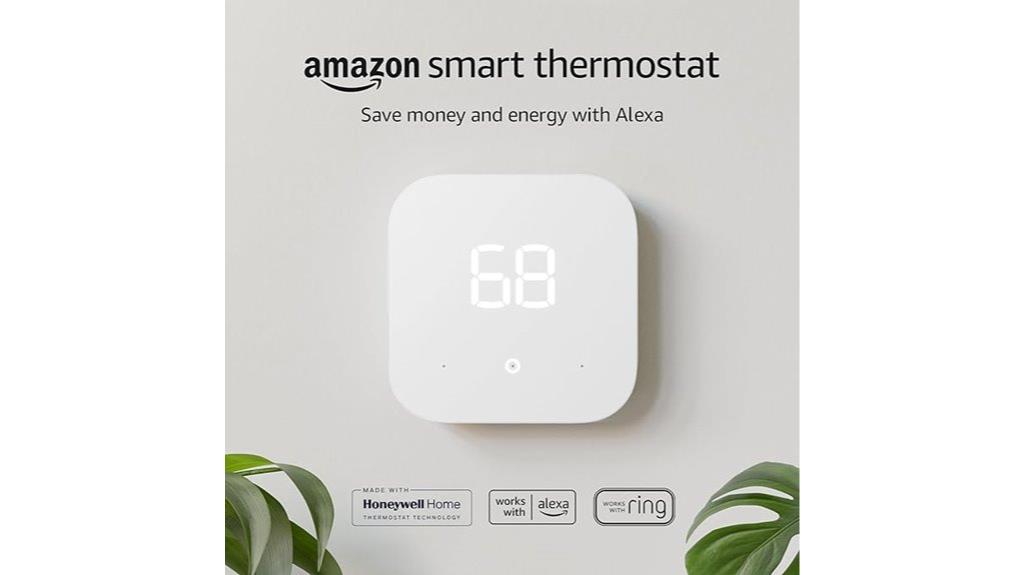
The Amazon Smart Thermostat is an excellent choice for homeowners who want a budget-friendly, easy-to-install smart thermostat that seamlessly integrates with Alexa. Made with Honeywell technology, it supports most 24V HVAC systems, including heat pumps and radiant boilers, but not electric baseboards. Setup is quick via the Alexa app, and control is simple through voice commands, the app, or on-device buttons. It offers scheduling, automatic temperature adjustments, and energy-saving features like Hunches. Compact and modern, it fits well into any home decor. With ENERGY STAR certification and a competitive price, it delivers reliable automation and energy savings, making it a smart upgrade for budget-conscious homeowners.
Best For: budget-conscious homeowners seeking an easy-to-install, Alexa-compatible smart thermostat that offers energy savings and seamless automation.
Pros:
- Affordable price point with potential rebates making it cost-effective
- Easy installation and setup via the Alexa app, suitable for DIY enthusiasts
- Supports automation features like scheduling, Hunches, and remote control through Alexa
Cons:
- Not compatible with 110-240V systems such as electric baseboards
- Occasional connectivity issues after power outages reported by some users
- Limited advanced customization compared to higher-end thermostats
ecobee Smart Thermostat Essential – Wi-Fi Programmable Thermostat
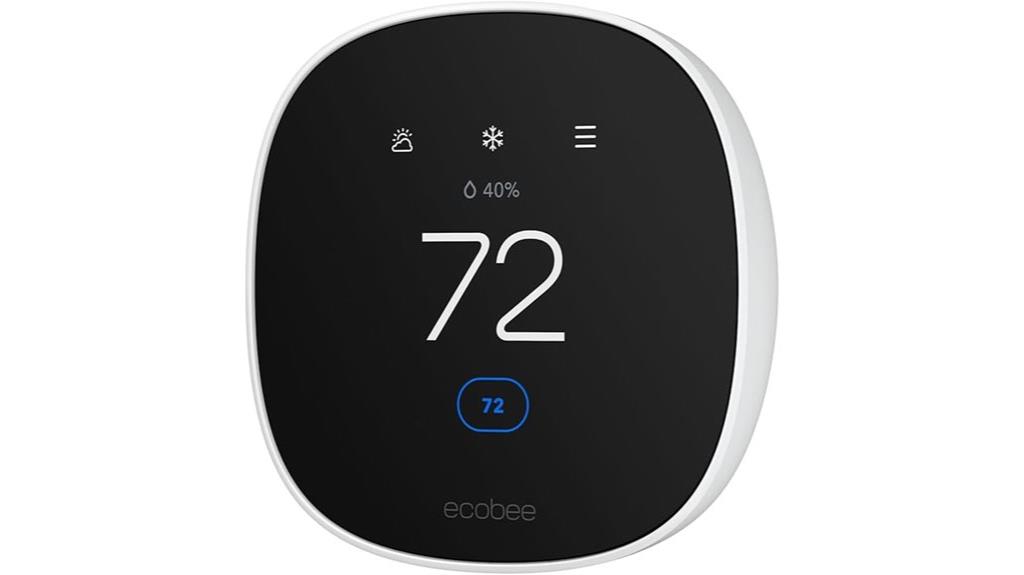
For those seeking an affordable yet highly capable smart thermostat, the ecobee Smart Thermostat Essential stands out with its ENERGY STAR certification and wide compatibility. It works seamlessly with Siri, Alexa, Google Assistant, Apple HomeKit, and Android, making smart home integration simple. Its auto-away mode, auto-scheduling, and fan control optimize energy use, saving up to 23% on bills—often paying for itself in just six months. Installation is straightforward with app guidance, and the sleek, round design fits well in any home. Users praise its reliability during extreme weather and intuitive app controls, making it a smart choice for efficient climate management.
Best For: homeowners seeking an affordable, compatible, and energy-efficient smart thermostat that easily integrates with popular voice assistants and smart home platforms.
Pros:
- Energy Star certified, capable of saving up to 23% on energy bills
- Compatible with Siri, Alexa, Google Assistant, Apple HomeKit, and Android for seamless smart home integration
- Easy to install and operate, with an intuitive app and sleek, modern design
Cons:
- Some users experience initial wiring challenges or need minor drywall modifications during installation
- Limited screen resolution may affect display clarity for some users
- Customer support experiences vary, with occasional delays or difficulty in wiring assistance
ecobee Smart Thermostat Premium with Smart Sensor and Air Quality Monitor

The ecobee Smart Thermostat Premium with Smart Sensor and Air Quality Monitor stands out for homeowners who want precise comfort control combined with energy savings. It can reduce heating and cooling costs by up to 26% annually and is ENERGY STAR certified. The included SmartSensor adjusts temperature in key rooms to eliminate hot and cold spots, while the built-in air quality monitor alerts you to poor air conditions and reminds you to change filters. Additional safety features include smoke detection and security alerts when system is armed. Compatible with most HVAC systems and supporting voice commands, it offers easy installation, an intuitive app, and smart scheduling for a customizable, efficient home climate.
Best For: homeowners seeking precise climate control, energy savings, and smart home integration with advanced features like air quality monitoring and occupancy sensing.
Pros:
- Up to 26% annual energy savings and ENERGY STAR certified for efficiency.
- Includes a SmartSensor to eliminate hot and cold spots and improve comfort.
- Supports multiple voice assistants and smart home platforms for seamless control.
Cons:
- Requires an Apple Home Hub for Siri functionality; not fully standalone.
- Some features, such as security alerts, need a subscription (ecobee Smart Security).
- Geographic restrictions limit location-based features to the US and Canada.
Honeywell Wi-Fi Smart Color Thermostat

If you’re looking for a smart thermostat that combines customizable control with seamless voice integration, the Honeywell Wi-Fi Smart Color Thermostat stands out. It features a vibrant 7-day programmable color touchscreen, supporting Alexa, Google Home, SmartThings, and IFTTT. Designed for heating and cooling systems, including heat pumps, it connects easily via Wi-Fi and offers remote control through your phone or computer. The device displays real-time weather, humidity, and system status, with intelligent alerts for filters and temperature warnings. Its intuitive interface and reliable Wi-Fi make managing your home climate straightforward, while energy-saving features help reduce utility bills.
Best For: homeowners and small business owners seeking a customizable, voice-controlled smart thermostat with vibrant display and energy-saving features.
Pros:
- Supports multiple voice assistants including Alexa, Google Home, SmartThings, and IFTTT for seamless integration.
- Features a bright, full-color touchscreen display with customizable scheduling options.
- Provides real-time weather, humidity, and system status updates, enhancing home climate management.
Cons:
- Installation can be tricky due to fragile wiring connectors; care is needed during setup.
- Some users report discrepancies in humidity and temperature readings compared to other sensors.
- Customer support wait times can be long, and advanced setup features may require manual configuration.
Google Nest Thermostat, Programmable Wi-Fi Smart Thermostat
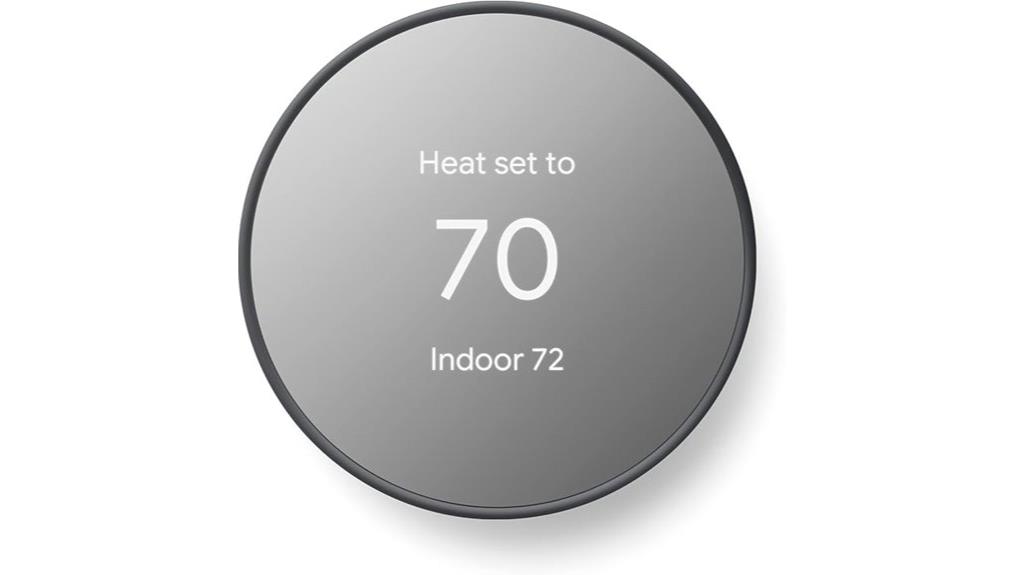
With its sleek design and intuitive controls, the Google Nest Thermostat stands out as an ideal choice for homeowners seeking energy-efficient, smart climate management. It’s compatible with most HVAC systems, including heat pumps and zone-controlled setups, and supports remote control via the Google Home app. The device features a user-friendly 2-inch LCD display, touchless controls, and voice command capabilities. It automatically adjusts settings based on occupancy, helping reduce energy bills. Easy to install in under 30 minutes, it’s backed by an ENERGY STAR certification and a one-year warranty. Overall, the Nest Thermostat offers a seamless, eco-friendly way to optimize your home’s comfort.
Best For: homeowners seeking an easy-to-install, energy-efficient smart thermostat compatible with a wide range of HVAC systems and remote control capabilities.
Pros:
- User-friendly 2-inch LCD display with touchless controls and voice command support.
- Supports energy savings features like occupancy-based adjustments and the Savings Finder tool.
- Compatible with most HVAC systems, including heat pumps and zone-controlled setups, with easy Wi-Fi connectivity.
Cons:
- May require a C wire or compatible power accessory for certain HVAC systems without a common wire.
- Limited to support for only two-stage heating or cooling systems.
- Occasional setup or wiring compatibility issues reported by some users.
Google Nest Learning Thermostat (3rd Gen, 2015) – Programmable Smart Thermostat

For homeowners seeking a sleek, intelligent thermostat that learns your routines and adapts to your lifestyle, the Google Nest Learning Thermostat (3rd Gen, 2015) stands out as an excellent choice. Its modern design features a bright digital display, stainless steel finish, and a smooth dial for easy control. It connects wirelessly via Wi-Fi and Bluetooth, supporting voice commands through Alexa and Google Assistant. The thermostat automatically creates a personalized schedule, switches to Away Mode when you’re gone, and detects motion with Far-Sight. With energy-saving estimates of up to 12% on heating and 15% on cooling, it’s a smart investment that enhances comfort and reduces bills.
Best For: homeowners who want a stylish, intelligent thermostat that learns their routines, offers remote control, and helps reduce energy bills.
Pros:
- Learns user schedules and adapts to preferences for optimal comfort and energy savings
- Supports remote control via Wi-Fi and Bluetooth, compatible with Alexa and Google Assistant
- Easy to install and operate, with a sleek modern design and user-friendly interface
Cons:
- Requires compatible HVAC system; compatibility check recommended before purchase
- Learning curve for new users unfamiliar with smart thermostats
- Battery life may require occasional replacement or recharging, depending on usage
Sensi Lite Smart Thermostat
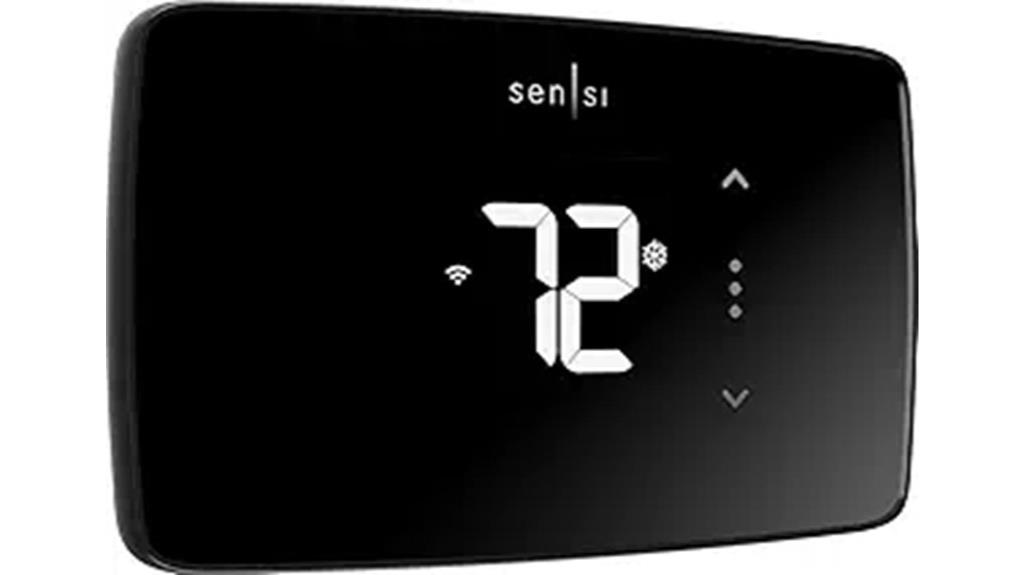
The Sensi Lite Smart Thermostat by Emerson stands out as an excellent choice for homeowners seeking an easy-to-install, budget-friendly device that offers reliable remote control. With its straightforward setup, including a built-in level and step-by-step instructions, most users can install it in about 10 minutes. Compatible with a wide range of HVAC systems, it supports Wi-Fi connectivity for remote adjustments via a user-friendly app on Android and iOS. It’s Energy Star certified, helping you save roughly 23% on energy costs through scheduling, geofencing, and usage reports. Its LCD display and voice assistant integrations make controlling your home climate simple and convenient.
Best For: homeowners seeking an affordable, easy-to-install smart thermostat with remote control capabilities and energy-saving features.
Pros:
- Simple DIY installation with built-in level and step-by-step instructions
- Compatible with most HVAC systems and supports Wi-Fi connectivity for remote control
- Energy Star certified, helping save approximately 23% on HVAC energy costs
Cons:
- Connectivity issues may occur during power outages or Wi-Fi signal loss
- Limited functionality outside North America due to regional restrictions
- Some users experience difficulty reconnecting after battery replacement or power interruptions
Honeywell WiFi Smart Thermostat RTH8800WF2022
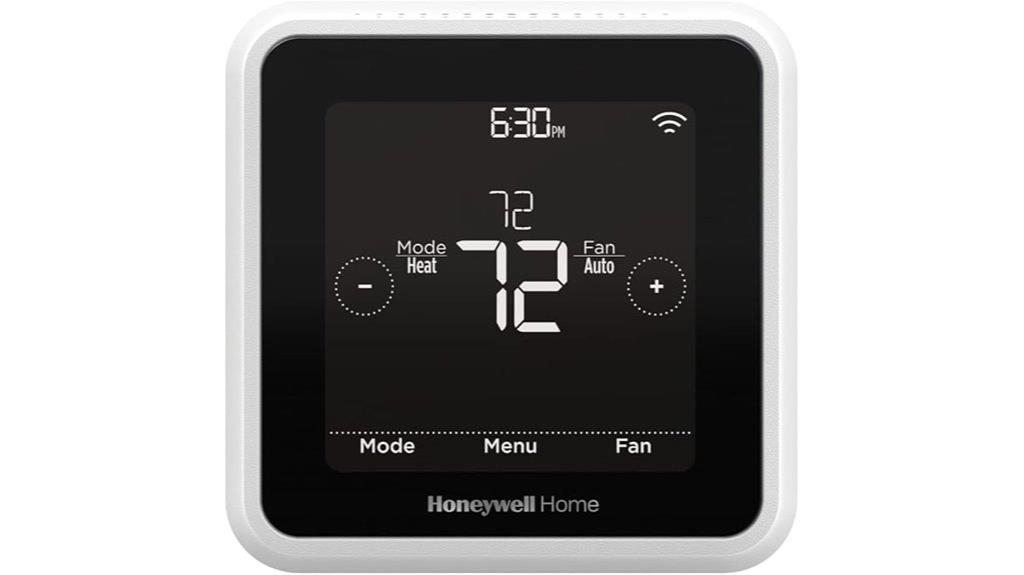
If you’re looking for a smart thermostat that combines affordability with robust features, the Honeywell WiFi Smart Thermostat RTH8800WF2022 is an excellent choice. It offers a 7-day programmable touchscreen, voice compatibility with Alexa, and geofencing technology to optimize energy use. ENERGY STAR certified, it helps save between 8-16% on heating and cooling bills. The device supports remote control via smartphone or tablet and includes features like auto home/away, vacation mode, and fan control. While installation requires a C-wire, users appreciate its sleek design, ease of use, and energy-saving potential—though some report connectivity issues.
Best For: homeowners seeking an affordable, feature-rich smart thermostat with remote control and energy-saving capabilities.
Pros:
- User-friendly touchscreen interface with sleek design
- Supports voice control via Alexa and geofencing technology
- ENERGY STAR certified, helping reduce energy bills by 8-16%
Cons:
- Requires a C-wire for installation, which may complicate setup for some users
- Occasional connectivity issues and integration challenges with third-party apps
- Smart features like adaptive recovery can override manual settings, causing user inconvenience
Sensi Touch 2 Smart Thermostat with Touchscreen
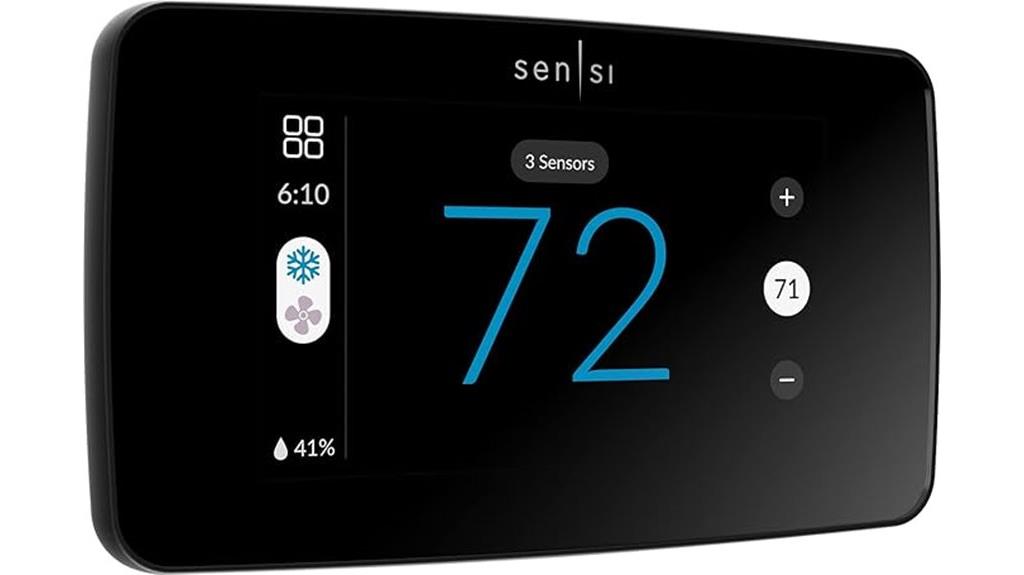
With its intuitive color touchscreen display and seamless smart home integration, the Sensi Touch 2 Smart Thermostat stands out as an excellent choice for homeowners seeking easy control and customization. It offers compatibility with Amazon Alexa, Google Assistant, and Samsung SmartThings, plus support for wireless room sensors. Its user-friendly app guides you through DIY installation, and the large touchscreen makes adjustments simple. Certified ENERGY STAR, it helps reduce energy use by around 23%, saving money over time. With features like smart maintenance alerts, privacy safeguards, and remote access, it’s a reliable, efficient upgrade that enhances comfort and control in any home.
Best For: homeowners seeking an easy-to-install, energy-efficient smart thermostat with seamless smart home integration and customizable comfort settings.
Pros:
- Intuitive color touchscreen display for simple navigation and control
- Compatible with Amazon Alexa, Google Assistant, and Samsung SmartThings for voice and app integration
- Supports wireless room sensors and smart maintenance alerts to optimize comfort and system performance
Cons:
- C-wire required for installation, which may necessitate additional wiring in some homes
- Initial Wi-Fi setup can be challenging, with PIN changes after failed attempts
- Limited to specific HVAC systems; may not be compatible with all existing setups
Emerson Sensi Touch Wi-Fi Smart Thermostat
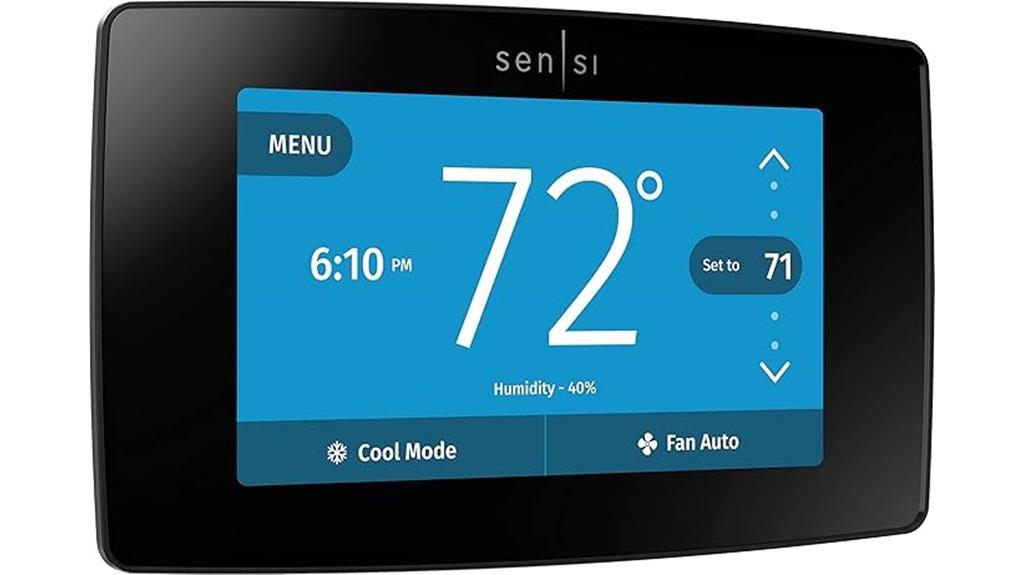
For homeowners seeking a sleek, easy-to-install smart thermostat that offers robust control options, the Emerson Sensi Touch Wi-Fi stands out. Its modern design features a large 4.3-inch touchscreen in black, white, or silver, making it a stylish addition to any home. It’s compatible with Alexa, Google Assistant, Apple HomeKit, and more, allowing voice, app, or touch control. Installation is straightforward thanks to clear wiring diagrams and step-by-step instructions. The thermostat supports energy-saving features like scheduling and remote access, helping reduce HVAC costs by about 23%. Plus, its reliable Wi-Fi connectivity and intuitive interface make managing your home climate simple and efficient.
Best For: homeowners seeking a sleek, easy-to-install smart thermostat with flexible control options and energy-saving features.
Pros:
- Modern design with a large, easy-to-read touchscreen display in multiple color options
- Simple DIY installation with clear wiring diagrams and app-guided setup
- Compatible with major voice assistants and supports remote control via app for convenience
Cons:
- Requires a common wire (C-wire) for power, which may not be available in all homes
- Initial calibration or Wi-Fi setup can be challenging for some users
- Proper configuration of HVAC system settings is essential to avoid operational issues
Meross Smart Thermostat with WiFi and Voice Control
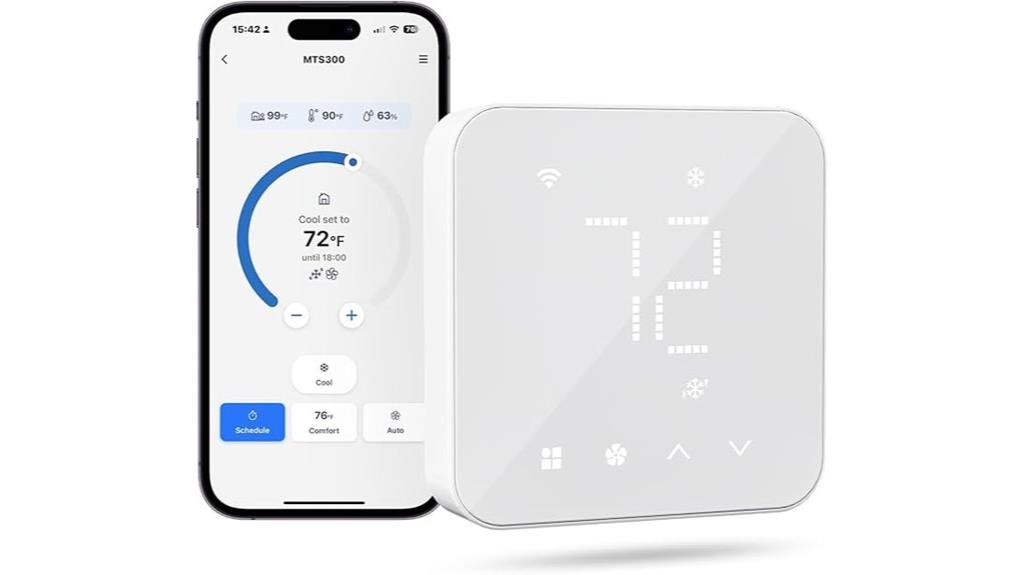
The Meross Smart Thermostat with WiFi and Voice Control stands out as an excellent choice for homeowners seeking reliable, voice-enabled temperature management. It supports most HVAC systems, including heating, cooling, and heat pumps, though not electric baseboard heaters. Compatible with 24V systems and requiring a C-wire, it connects via 2.4GHz Wi-Fi and uses the Matter protocol for seamless integration with Apple Home, Alexa, Google, and Samsung SmartThings. Its app allows remote control, scheduling, and energy tracking. Compact and portable, it features an LED display, lock function, and easy wall mounting. Overall, it’s a versatile, user-friendly thermostat that can considerably enhance your home’s climate control.
Best For: homeowners seeking a reliable, voice-controlled smart thermostat compatible with a wide range of HVAC systems and integrated smart home platforms.
Pros:
- Supports 95% of HVAC systems, including heating, cooling, and heat pumps.
- Compatible with major smart home ecosystems like Apple Home, Alexa, Google Home, and Samsung SmartThings.
- Features remote control, scheduling, energy tracking, and an easy-to-use app interface.
Cons:
- Not suitable for electric baseboard heaters.
- Requires a 24V HVAC system with a C-wire for proper installation.
- Limited battery backup options, as it relies on corded power and no batteries are included.
Honeywell Home Smart Thermostat, WiFi Compatible
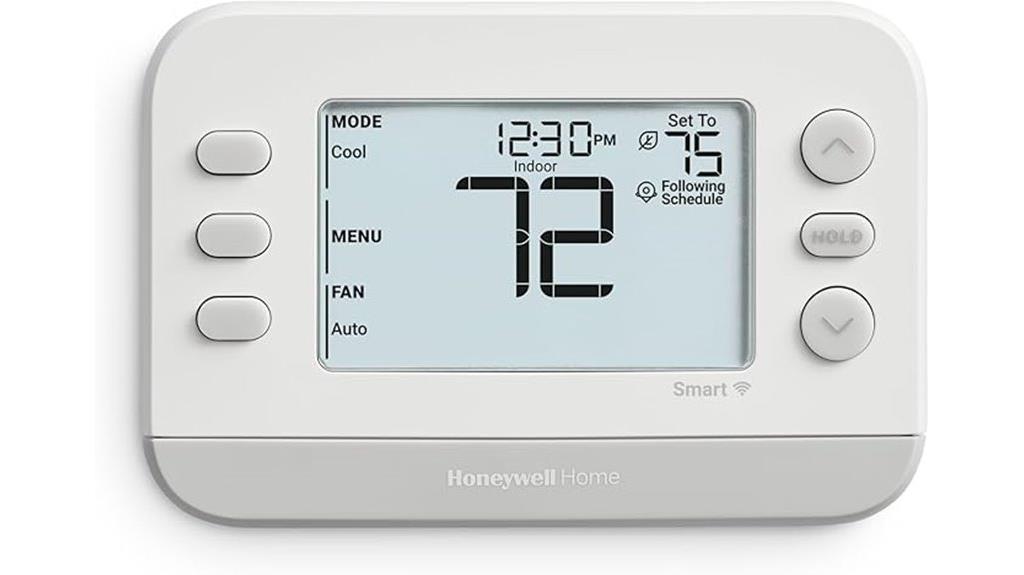
If you’re looking for a smart thermostat that seamlessly integrates with your existing home system, the Honeywell Home Smart Thermostat, WiFi Compatible, stands out thanks to its Matter certification and broad compatibility. I appreciate its support for Amazon Alexa, Google Assistant, and Apple HomeKit, making voice control effortless. Its customizable display, humidity monitoring, and auto-away feature help optimize energy use, saving you money. The ENERGY STAR certification reassures me about its efficiency. Plus, with remote control via the app and demand response capabilities, I can easily manage my home’s climate from anywhere. It’s a versatile, energy-efficient option that fits well into most smart home setups.
Best For: smart homeowners seeking a versatile, energy-efficient thermostat that integrates seamlessly with various voice assistants and smart home systems.
Pros:
- Supports multiple voice control platforms including Alexa, Google Assistant, and Apple HomeKit for easy voice commands.
- Certified with Matter and ENERGY STAR, ensuring compatibility and energy efficiency.
- Customizable display features, humidity monitoring, and auto-away for optimal comfort and savings.
Cons:
- Requires a 24V AC power source, which may not be compatible with all existing wiring setups.
- Slightly higher price point compared to basic thermostats, reflecting its advanced features.
- Limited to certain HVAC systems (conventional and heat pump up to specified configurations), so compatibility should be verified.
RTH6580WF Wi-Fi 7-Day Programmable Thermostat, White
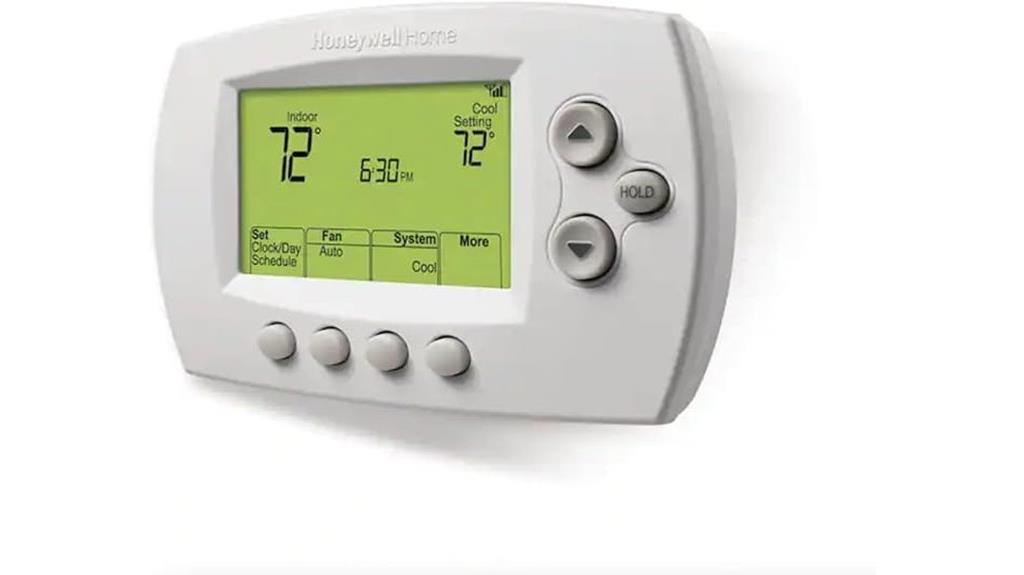
The RTH6580WF Wi-Fi 7-Day Programmable Thermostat from Honeywell Home stands out for homeowners seeking energy savings combined with easy control via smartphone or voice commands. Its large backlit display makes adjustments simple, and it supports multiple systems like forced air, hot water, steam, and heat pumps with electric backup. With WiFi connectivity, I can control my home’s temperature remotely through apps or voice assistants like Alexa, Google, or Cortana. The thermostat learns routines with Smart Response Technology, optimizing comfort and efficiency. Plus, it’s easy to install and Energy Star certified, making it a smart choice for modern, connected homes.
Best For: homeowners seeking an energy-efficient, easy-to-use Wi-Fi-enabled thermostat with smart home integration and remote control capabilities.
Pros:
- Supports multiple HVAC systems including forced air, hot water, steam, and heat pumps with electric backup.
- Compatible with voice assistants like Amazon Alexa, Google Assistant, and Microsoft Cortana for hands-free control.
- Energy Star certified, ensuring energy savings without compromising comfort, with features like auto changeover and Smart Response Technology.
Cons:
- Requires a C-wire for power, which may necessitate additional wiring for some systems.
- Initial setup and WiFi connection troubleshooting can be complex for DIY users unfamiliar with network configurations.
- Lacks a touchscreen interface, relying on physical buttons and a backlit display for adjustments.
Google Nest Learning Thermostat (4th Gen, 2024)
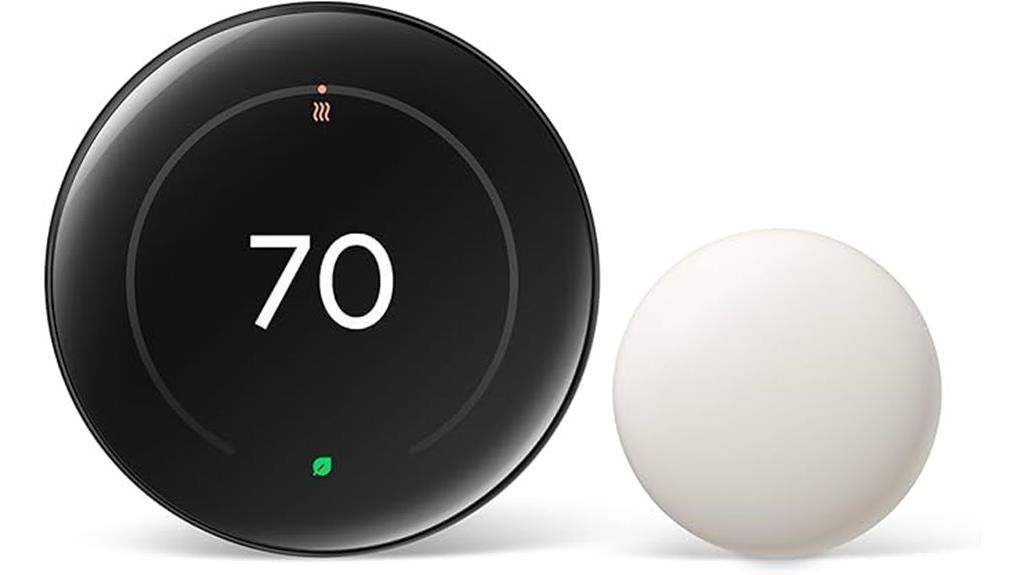
For homeowners seeking a highly intelligent and customizable thermostat, the Google Nest Learning Thermostat (4th Gen, 2024) stands out with its advanced learning capabilities and sleek design. It features a polished obsidian finish, a larger touchscreen with Dynamic Farsight, and customizable displays like clock or weather. It adapts to your routines, automatically adjusting heating and cooling to maximize comfort and energy savings—around 12% on heating and 15% on cooling bills. Compatible with most 24V systems and supporting Wi-Fi, voice assistants, and Matter, it’s easy to control remotely via the Google Home app. Its intuitive features and modern look make it a top choice for smart homes.
Best For: homeowners seeking an advanced, customizable, and energy-efficient smart thermostat with sleek design and easy remote control.
Pros:
- Learns user routines and automatically adjusts schedules for optimal comfort and savings
- Large, dynamic touchscreen display with customizable clock or weather modes
- Compatible with most 24V systems and supports Wi-Fi, voice assistants, and Matter integration
Cons:
- Higher price point compared to basic thermostats
- Requires a Wi-Fi connection for full functionality, which may pose issues in weak signal areas
- Installation may be complicated for some users without professional help
Factors to Consider When Choosing Smart Thermostats

When choosing a smart thermostat, I consider how well it functions with my HVAC system and how easy it is to install. I also look for features that integrate smoothly with my smart home devices and help save energy. Finally, I pay attention to the user interface to guarantee it’s simple and intuitive to use.
Compatibility With HVAC Systems
Choosing a smart thermostat that works seamlessly with your HVAC system requires careful attention to compatibility factors. First, check that the thermostat supports your system’s voltage and wiring, whether it’s 24V, 110V, or 240V, to avoid installation issues. Next, verify that your system can handle the specific heating and cooling functions you need, like heat pumps, boilers, or electric baseboards. It’s also important to confirm whether your system uses single-stage, multi-stage, or zone control, so the thermostat can deliver full functionality. Additionally, determine if your thermostat requires a common wire (C-wire) for power or if it offers alternative options like power extenders or batteries. In conclusion, review the manufacturer’s compatibility list or use online tools to match your HVAC specs before buying.
Ease of Installation
Installing a smart thermostat can be straightforward if you select a model designed for easy setup. Many models are built for DIY installation, featuring built-in levels and step-by-step app guidance to simplify wiring. Compatibility with your existing HVAC wiring, especially the presence of a C-wire, plays a vital role—some units may require adapters or additional wiring. Clear instructions and user-friendly apps help reduce setup time and minimize errors, making installation accessible even if you’re not technically inclined. Devices with universal wiring compatibility and simple mounting options are ideal for quick, hassle-free setup. Additionally, troubleshooting support and online tutorials can help resolve common issues, giving you confidence that installing your new thermostat will be a smooth process.
Smart Home Integration
Smart home integration is a key factor to think about when selecting a thermostat, as it determines how well your new device will work with your existing smart ecosystem. Compatibility with platforms like Alexa, Google Assistant, Apple HomeKit, and Samsung SmartThings guarantees seamless control and voice commands. Support for protocols such as Matter, Z-Wave, or Zigbee can expand connectivity, letting your thermostat communicate with a wider range of smart devices. Many models offer remote management through mobile apps, so you can adjust settings anytime, anywhere. Additionally, integration allows your thermostat to share data with security systems or sensors, optimizing comfort and energy use automatically. Keep in mind that compatibility may require specific hubs, bridges, or apps, which can influence setup complexity and system interoperability.
Energy Saving Features
To maximize energy savings, look for thermostats equipped with adaptive learning algorithms that automatically fine-tune temperatures based on your daily routines. These smart systems analyze your habits and adjust settings to optimize efficiency without manual input. Additionally, choose models with zone-specific or smart sensors that detect occupancy and temperature fluctuations, preventing unnecessary heating or cooling in unused areas. Support for geofencing technology is also essential, as it uses your smartphone location to reduce energy use when you’re away. Make sure the thermostat provides detailed energy reports and usage analytics, helping you identify further savings opportunities. Finally, devices with programmable schedules and auto-away modes can cut heating and cooling costs by up to 26%, making your home both smarter and more energy-efficient.
User Interface Design
Choosing a smart thermostat with an intuitive user interface can make a significant difference in how easily you manage your home’s climate. A clear visual layout and simple navigation reduce setup time and make adjustments straightforward. Touchscreens with responsive controls, like LCD or color displays, let you tweak settings quickly and see real-time feedback. Physical buttons or dials can offer more reliable manual control, especially during power outages or system malfunctions. User-friendly interfaces typically include features like scheduling, manual override, and energy monitoring, all accessible through simple menus. Seamless integration with mobile apps and voice commands adds convenience, allowing you to control your thermostat remotely. Ultimately, a well-designed interface guarantees a smoother, more efficient experience in maintaining your ideal home environment.
Frequently Asked Questions
How Do Smart Thermostats Integrate With Existing Home Automation Systems?
Smart thermostats easily integrate with existing home automation systems by connecting via Wi-Fi or Zigbee/Z-Wave protocols. I simply link them through compatible apps or control hubs, allowing me to automate temperature adjustments alongside lighting, security, and other devices. This seamless integration means I can control everything from a single app or voice commands, making my home more efficient and comfortable without hassle.
Can Smart Thermostats Detect and Respond to Occupancy Automatically?
Think of a smart thermostat as a vigilant guardian, always watching over your home. Yes, it can detect and respond to occupancy automatically. It uses sensors and learning algorithms to identify when you’re home or away, adjusting the temperature accordingly. This means I don’t have to lift a finger — my system adapts seamlessly, saving energy and keeping my home cozy without any manual intervention.
What Are the Privacy and Security Concerns With Smart Thermostat Data?
I’m concerned about privacy and security with smart thermostat data because it collects detailed info about my home, habits, and routines. If hackers access this data, they could misuse it or even gain control over my home’s climate system. That’s why I make sure to choose reputable brands, update firmware regularly, and use strong, unique passwords to protect my personal information from potential breaches.
How Do Smart Thermostats Adapt to Seasonal Climate Changes?
Smart thermostats adapt to seasonal climate changes by learning your schedule and preferences, then adjusting the temperature automatically. They use sensors and weather data to optimize comfort and efficiency, making real-time changes based on outdoor temperatures and your habits. I find that their ability to anticipate needs helps maintain a cozy home year-round while saving energy. This adaptive technology guarantees I stay comfortable no matter the season.
Are There Energy-Saving Incentives or Rebates for Installing Smart Thermostats?
When I installed my smart thermostat, I found out many utility companies offer rebates that cut costs considerably. I saved around $100 thanks to these incentives, which felt like getting a bonus for making eco-friendly choices. Many regions have similar programs to encourage energy efficiency, so it’s worth checking local or state incentives before installation. These rebates make upgrading both affordable and rewarding!
Conclusion
Choosing the right smart thermostat means choosing convenience, efficiency, and control. It’s about finding a device that learns your habits, adapts to your schedule, and helps you save energy. It’s about enhancing comfort, simplifying management, and upgrading your home. Whether you prefer sleek design, advanced features, or easy setup, there’s a thermostat that fits your needs. Make your home smarter, your life easier, and your climate just right—because you deserve the best.









